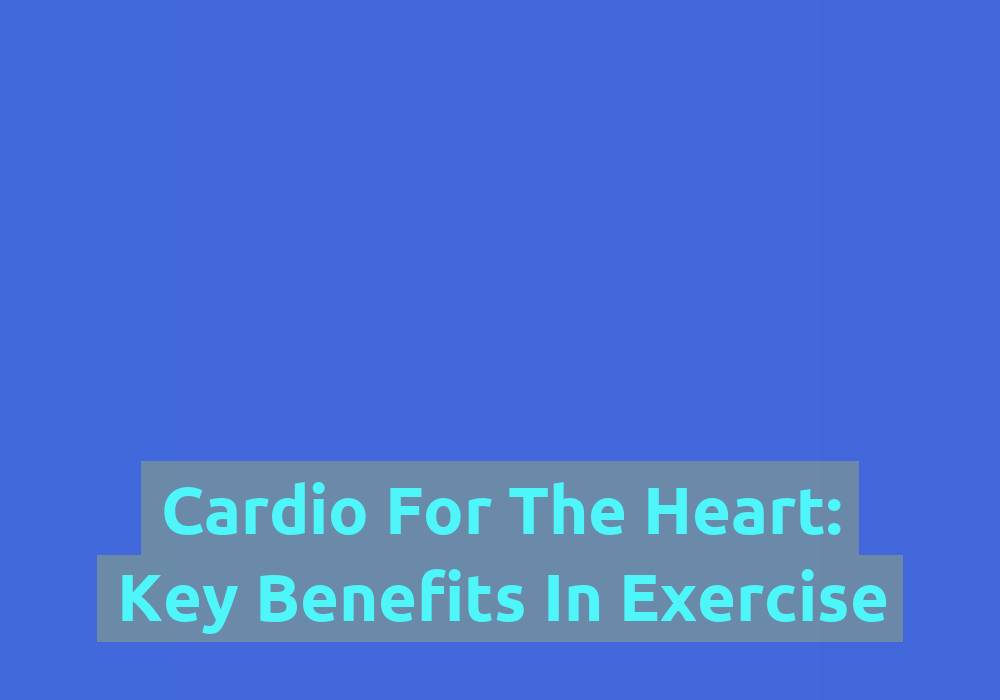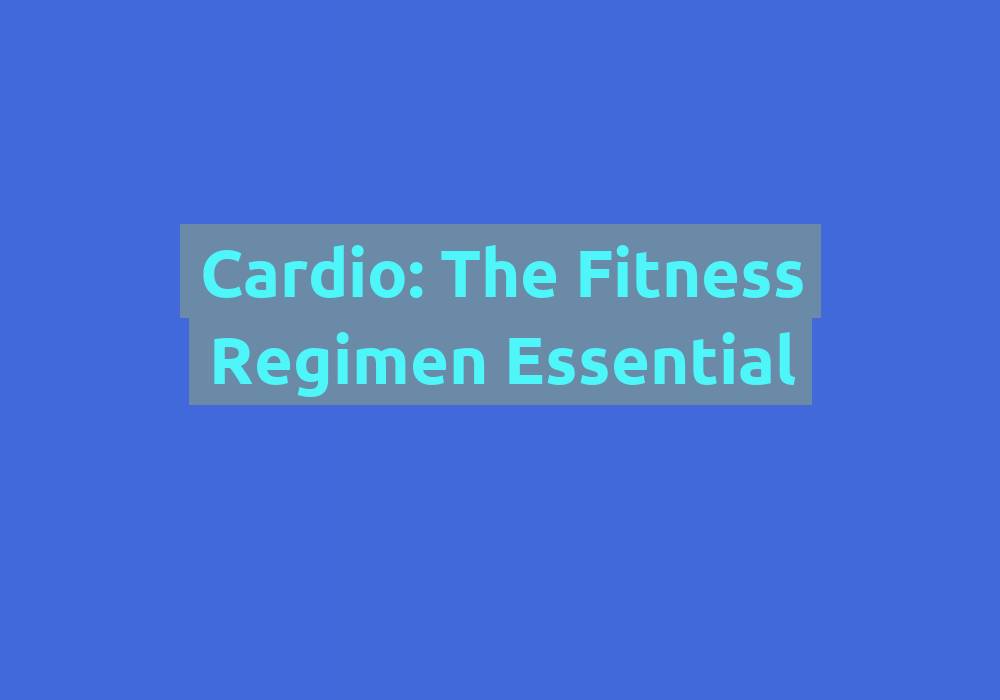Cardio for the Heart: Key Benefits in Exercise

Cardiovascular exercise, also known as cardio, is any form of physical activity that raises your heart rate and strengthens your heart and circulatory system. Regular cardio workouts have numerous benefits for your overall health and well-being. In this article, we will explore the key advantages of cardiovascular exercise and its impact on heart health.
Importance of Cardiovascular Exercise
Engaging in regular cardio workouts is essential for maintaining a healthy heart and reducing the risk of cardiovascular diseases. Let’s take a closer look at the importance of cardiovascular exercise:
Strengthening the Heart Muscle: Cardio exercises help to strengthen your heart muscle, making it more efficient at pumping blood. This increased efficiency reduces the strain on your heart and lowers the risk of developing heart diseases such as coronary artery disease, heart attacks, and strokes.
Enhancing Circulation: Cardio workouts promote better blood flow and circulation throughout your body. As you exercise, your blood vessels dilate, allowing blood to flow more freely and delivering essential nutrients and oxygen to your organs and tissues. Improved circulation also aids in the removal of waste products from your body.
Improving Oxygen and Nutrient Delivery: By incorporating cardio into your routine, you can improve the efficiency of oxygen and nutrient delivery throughout your body. This ensures that all organs and tissues receive the necessary fuel to function optimally.
Key Benefits of Cardio Exercise for the Heart
Regular cardiovascular exercise offers a range of benefits for heart health. Let’s explore some of these benefits in more detail:
Enhanced Heart Health: Engaging in cardio exercises regularly strengthens your heart muscle, making it more efficient at pumping blood. This increased efficiency reduces the strain on your heart and lowers the risk of developing heart diseases such as coronary artery disease, heart attacks, and strokes.
Improved Blood Circulation: Cardio workouts promote better blood flow and circulation throughout your body. As you exercise, your blood vessels dilate, allowing blood to flow more freely and delivering essential nutrients and oxygen to your organs and tissues. Improved circulation also aids in the removal of waste products from your body.
Lower Blood Pressure: Regular cardio exercise has been shown to lower blood pressure levels, especially in individuals with hypertension (high blood pressure). By reducing blood pressure, you can significantly decrease the risk of heart disease and stroke.
Reduced Cholesterol Levels: Cardiovascular exercise helps to raise the levels of high-density lipoprotein (HDL) cholesterol, also known as good cholesterol, while reducing the levels of low-density lipoprotein (LDL) cholesterol, or bad cholesterol. This balance promotes a healthier lipid profile, reducing the risk of plaque buildup in the arteries and lowering the chances of heart disease.
Weight Management: Engaging in regular cardio workouts is an effective way to manage and maintain a healthy weight. Cardio exercises burn calories, helping you shed excess pounds and prevent weight gain. Maintaining a healthy weight not only reduces the strain on your heart but also decreases the risk of various cardiovascular diseases associated with obesity.
Enhanced Endurance and Stamina: Regular cardio exercise improves your endurance and stamina by strengthening your heart and lungs. As your cardiovascular fitness improves, you will find yourself less fatigued during everyday activities and better equipped to handle physical exertion that may have previously left you breathless.
Improved Mood and Mental Well-being: Cardio workouts release endorphins, commonly known as feel-good hormones, which can enhance your mood and reduce symptoms of stress, anxiety, and depression. Engaging in cardio exercise also promotes better sleep patterns, leading to improved mental well-being and overall quality of life.
Types of Cardio Exercises
There are various types of cardio exercises to choose from, allowing you to find activities that suit your preferences and fitness levels. Some popular forms of cardiovascular exercise include:
- Running or Jogging: Running or jogging is a versatile and accessible form of cardio exercise that can be done outdoors or on a treadmill. It helps improve cardiovascular endurance and burns a significant number of calories.
- Cycling: Cycling is a low-impact cardio exercise that can be enjoyed outdoors or indoors on a stationary bike. It strengthens the lower body muscles and improves cardiovascular fitness.
- Swimming: Swimming is a full-body workout that is gentle on the joints. It improves cardiovascular endurance, muscle strength, and flexibility.
- Brisk Walking: Brisk walking is a simple yet effective cardio exercise that can be easily incorporated into your daily routine. It is a low-impact activity that helps improve cardiovascular health.
- Dancing: Dancing is a fun and energetic way to get your heart rate up and burn calories. It offers a wide variety of styles to choose from, such as salsa, hip-hop, or Zumba.
- Aerobics or Zumba: Aerobic workouts and Zumba classes combine cardiovascular exercise with dance movements, offering a fun and engaging way to improve heart health.
- HIIT (High-Intensity Interval Training): HIIT involves short bursts of intense exercise followed by periods of rest or low-intensity exercise. It is an efficient way to improve cardiovascular fitness and burn calories.
- Jumping Rope: Jumping rope is a simple and portable cardio exercise that can be done anywhere. It improves cardiovascular endurance and coordination.
Incorporating Cardio into Your Fitness Routine
To reap the benefits of cardio exercise, it is recommended to incorporate at least 150 minutes of moderate-intensity cardio workouts or 75 minutes of vigorous-intensity workouts per week. Here are a few tips to help you get started:
Choose Activities You Enjoy: Find cardio exercises that you genuinely enjoy doing. This will increase motivation and make it easier to stick to your fitness routine. Whether it’s running, cycling, or dancing, find activities that make you feel excited to get moving.
Start Slowly: If you are new to cardio exercise, begin with shorter sessions at a lower intensity and gradually increase the duration and intensity over time. This approach will help prevent injuries and allow your body to adapt to the increased demands. Listen to your body and give yourself time to progress.
Mix Up Your Routine: Variety is key to preventing boredom and maintaining motivation. Incorporate different forms of cardio exercises in your routine to keep things interesting and challenge your body in new ways. Try alternating between running, cycling, and swimming, or explore different dance styles to keep your workouts exciting.
Listen to Your Body: Pay attention to how your body feels during and after exercise. If you experience pain or discomfort, adjust your routine or seek guidance from a fitness professional. It’s important to listen to your body’s signals and make modifications as needed to avoid injury.
Make it a Habit: Consistency is crucial when it comes to cardiovascular exercise. Aim to make it a regular part of your routine by scheduling workouts and prioritizing your health. Find a time of day that works best for you and stick to it. The more you make cardio exercise a habit, the easier it will be to maintain a healthy lifestyle.
Conclusion
Cardiovascular exercise plays a vital role in promoting heart health and overall well-being. By incorporating regular cardio workouts into your fitness routine, you can reap numerous benefits, including improved heart health, enhanced blood circulation, lower blood pressure, reduced cholesterol levels, weight management, increased endurance, and improved mood. Choose activities that you enjoy, start slowly, and make it a habit. Your heart will thank you for prioritizing its health through cardio exercise.
Note: This article is presented in markdown format as per the provided instructions.
FAQ
- Why is cardiovascular exercise important for heart health?
Engaging in regular cardio workouts helps strengthen the heart muscle, improves blood circulation, enhances oxygen and nutrient delivery, and reduces the risk of heart diseases such as coronary artery disease, heart attacks, and strokes.
- How does cardiovascular exercise lower blood pressure?
Regular cardio exercise has been shown to lower blood pressure levels, especially in individuals with hypertension. By reducing blood pressure, it significantly decreases the risk of heart disease and stroke.
- How does cardiovascular exercise help in weight management?
Engaging in regular cardio workouts helps burn calories, allowing you to shed excess pounds and prevent weight gain. Maintaining a healthy weight reduces the strain on your heart and decreases the risk of cardiovascular diseases associated with obesity.
- What are some popular forms of cardiovascular exercise?
Some popular forms of cardiovascular exercise include running or jogging, cycling, swimming, brisk walking, dancing, aerobics or Zumba, HIIT (High-Intensity Interval Training), and jumping rope.










